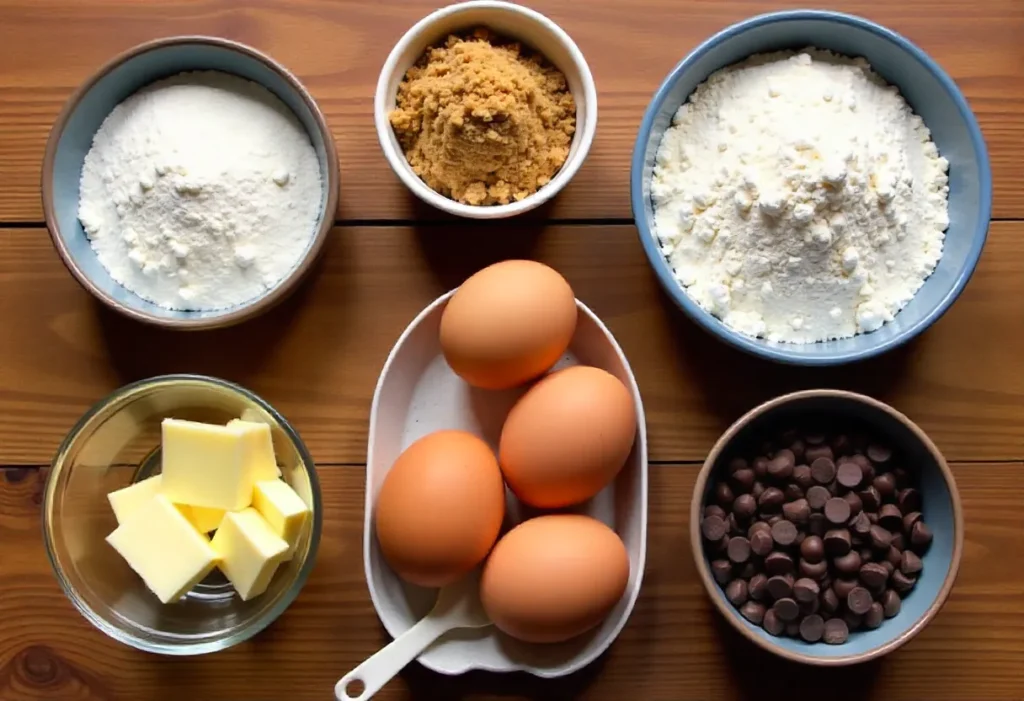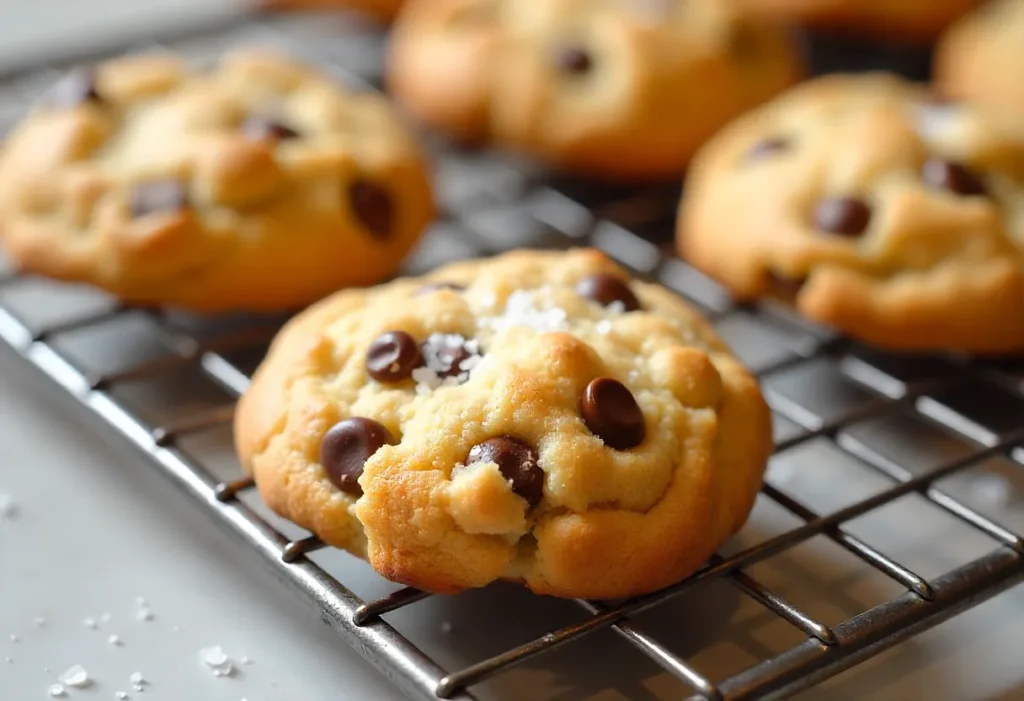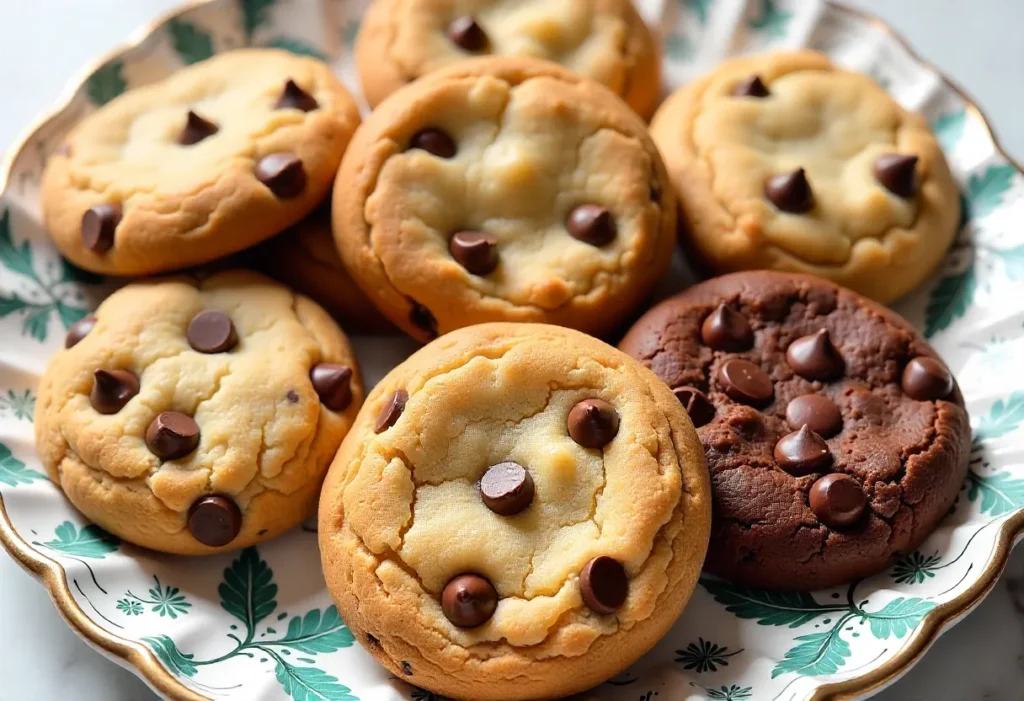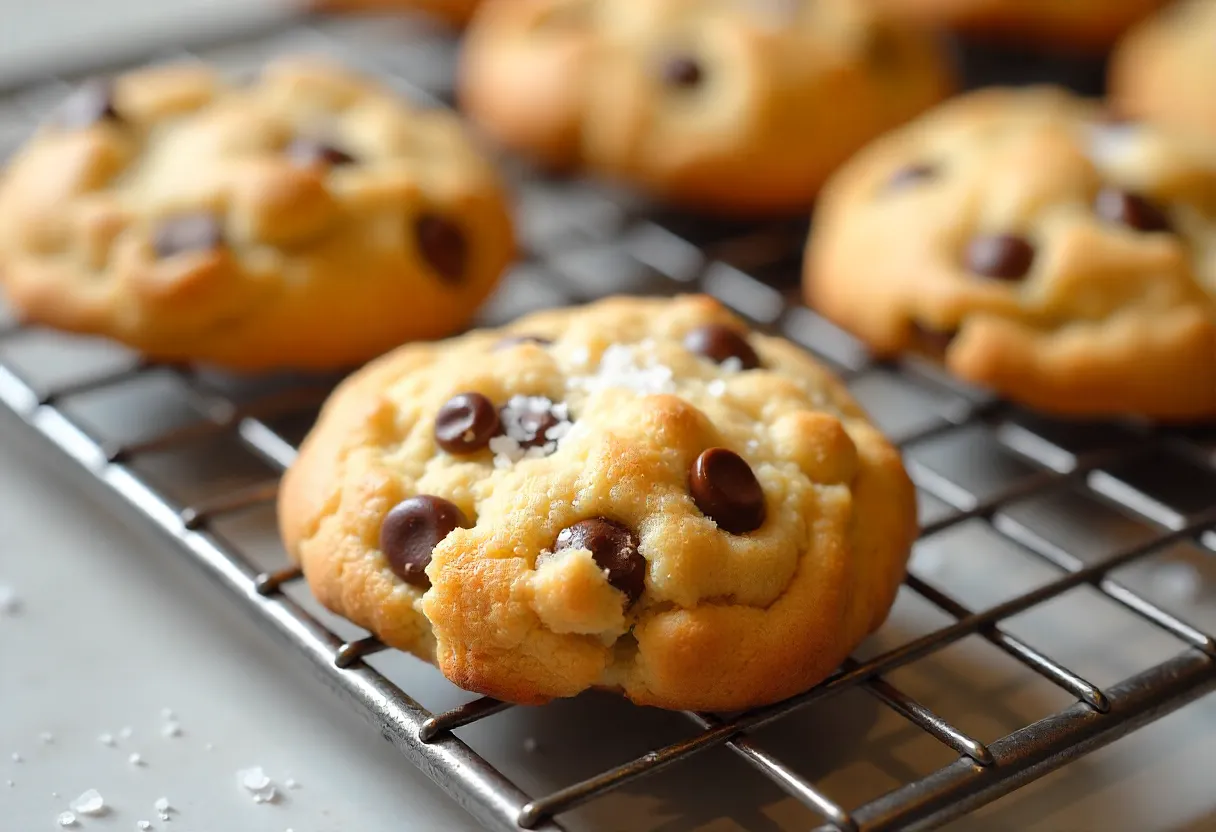Introduction
Few desserts in the world can spark nostalgia and pure joy the way a warm, freshly baked chocolate chip cookie does. The smell of buttery dough and melting chocolate wafting from the oven instantly transforms any kitchen into the coziest place on earth. But while countless recipes claim to be the best, only a handful truly deliver that perfect balance of crispy edges, chewy centers, and rich chocolatey flavor.
In this guide, we’ll walk you through everything you need to know to bake the best chocolate chip cookies you’ve ever tasted. From choosing the right ingredients to mastering baking techniques, you’ll discover the small details that make a big difference. Whether you’re a beginner baker or someone who has tried dozens of cookie recipes, this comprehensive breakdown will help you achieve bakery-quality results right at home.
Why trust this recipe over the thousands floating around online? Because it combines tried-and-tested baking science with practical tips that real home bakers swear by. You’ll learn not just what ingredients to use, but why they matter. We’ll cover everything from the type of butter that yields the richest flavor to how long you should chill your dough for the ultimate texture..Healthy Dessert with Protein Powder
By the time you finish reading this, you won’t just have a recipe you’ll have the knowledge to consistently bake cookies that make people stop mid-bite and say, “Wow… these really are the best chocolate chip cookies!”
So, preheat your oven, grab your mixing bowl, and let’s dive into the secrets of baking perfection.
Why These Are the Best Chocolate Chip Cookies
Every baker has a personal idea of what makes the best chocolate chip cookies. Some prefer a soft, cake-like texture, while others crave crispy, buttery rounds with a snap. But when most people talk about the “perfect” cookie, they’re describing something that hits a sweet spot: slightly crisp on the edges, delightfully chewy in the middle, and loaded with gooey chocolate chips in every bite.
This recipe isn’t just about following steps it’s about understanding why certain methods create those sought-after textures and flavors. Let’s break down the qualities that make these cookies a cut above the rest.
The Perfect Texture: Chewy, Crispy, and Soft
A winning chocolate chip cookie has three layers of texture working together:
- Crispy edges that add a satisfying crunch.
- Chewy centers that feel rich and indulgent.
- Soft, slightly underbaked middles that give that melt-in-your-mouth sensation.
This balance is achieved through a careful ratio of butter, sugar, and flour, plus the right baking time and temperature. Using more brown sugar than white sugar, for example, helps the cookies stay moist and chewy because brown sugar retains more moisture. Meanwhile, a higher oven temperature gives the edges that golden crispness while leaving the inside tender.
It’s this interplay of ingredients and technique that makes these cookies stand out from the thousands of other recipes you’ll find.
Balanced Sweetness and Rich Flavor
Let’s face it cookies are indulgent by nature. But the best chocolate chip cookies don’t overwhelm your taste buds with sweetness. Instead, they balance sugary notes with buttery richness, a hint of salt to cut through the sugar, and, of course, the slightly bitter depth of semi-sweet or dark chocolate.
Using quality vanilla extract adds warmth and aroma, while a sprinkle of flaky sea salt on top creates contrast that makes every bite more complex. The flavor isn’t one-note; it’s layered, so you can enjoy different elements as you savor each bite.
A Recipe Tested and Loved by Bakers
What makes this recipe even more trustworthy is that it has been tried, tested, and refined by home bakers and professionals alike. Time and again, people report back with the same reaction: “These are the cookies I’ve been searching for.”
Unlike many recipes that cut corners, this one focuses on doing things right. That means creaming the butter and sugar properly, allowing the dough to chill for deeper flavor development, and not overbaking. These small but important details are the difference between cookies that are just “good” and cookies that earn the title of “the best.”
Another key reason these cookies work for so many people is their reliability. Whether you’re baking in a humid climate or a dry one, whether you use a stand mixer or mix by hand, the recipe holds up. That consistency is what makes it a true favorite across kitchens worldwide..Homemade Protein Sweets

Key Ingredients for the Best Chocolate Chip Cookies
The foundation of any great cookie lies in its ingredients. While the ingredient list may look simple flour, butter, sugar, eggs, vanilla, and chocolate chips the secret to the best chocolate chip cookies isn’t just what you use, but how you use it. Each component plays a critical role in shaping the cookie’s taste, texture, and appearance. Let’s break it down.
Choosing the Right Butter
Butter is the heart of a chocolate chip cookie. It adds richness, tenderness, and that irresistible flavor we all crave. But not all butter is created equal:
- Salted vs. Unsalted Butter: Most bakers recommend using unsalted butter because it allows you to control the exact salt content of the dough. Salted butter can sometimes throw off the balance, making the cookies too salty.
- Quality Matters: High-fat European-style butter often produces cookies with a deeper, more indulgent flavor.
- Melted, Softened, or Browned?: Softened butter (at room temperature) is ideal for creaming with sugar, creating air pockets that give the cookies structure. For an extra layer of nutty flavor, some bakers brown their butter before adding it to the dough, which adds a toffee-like richness.
The Role of Brown vs. White Sugar
Sugar isn’t just for sweetness it also affects texture:
- White Sugar: Creates crispness. The more white sugar, the crunchier the cookie.
- Brown Sugar: Adds moisture and chewiness because it contains molasses. It also deepens the flavor, giving the cookie a slight caramel undertone.
- The Perfect Ratio: The best chocolate chip cookies often use a higher proportion of brown sugar to white sugar. This balance ensures a chewy center without sacrificing that delicate crisp edge.
Best Flour for Cookie Structure
Flour provides the backbone of your cookie. But did you know different types of flour can drastically change the outcome?
- All-Purpose Flour: The most common choice, providing just the right amount of protein for structure while still keeping cookies tender.
- Bread Flour: Higher in protein, it produces chewier cookies with more bite. Some bakers use a mix of bread flour and all-purpose flour for the best of both worlds.
- Measuring Tip: Always spoon flour into your measuring cup instead of scooping directly, as scooping can lead to compacted flour and dry, cakey cookies. (See how to measure flour correctly for expert advice.)
Eggs and Vanilla Extract
Eggs are the binding agents that hold everything together. They also contribute to the cookie’s richness and texture:
- Whole Eggs: Provide structure and moisture.
- Extra Yolk: Some recipes add an extra yolk for extra chewiness since the yolk contains fat.
- Vanilla Extract: This may seem like a minor addition, but real vanilla extract elevates the flavor of the dough, enhancing both the sweetness and the chocolate. For best results, use pure vanilla extract rather than artificial flavoring.
Picking the Best Chocolate Chips
Of course, no chocolate chip cookie is complete without the chocolate itself. But with so many options available, which should you choose?
- Semi-Sweet Chips: The classic choice, offering a balance of sweetness and depth.
- Dark Chocolate: For those who prefer a less sweet, more intense flavor. (Learn more about the benefits of dark chocolate.)
- Milk Chocolate: Sweeter and creamier, perfect for kids or those who like a lighter chocolate profile.
- Chunks vs. Chips: While chips are convenient, chunks of chopped chocolate melt into pockets that give a more luxurious texture. Mixing both chips and chunks can provide the ultimate experience.
By paying attention to these core ingredients and their roles, you’re already halfway to baking the best chocolate chip cookies of your life. Remember, cookies are only as good as what goes into them.

Step-by-Step Recipe Instructions
Now that we’ve covered the key ingredients, it’s time to put them together. Baking the best chocolate chip cookies is less about complicated techniques and more about paying attention to details. Follow these steps carefully, and you’ll get perfect results every time.
Preparing the Dough
- Cream the Butter and Sugars
Start with softened butter at room temperature. Place it in a large mixing bowl with both the white sugar and brown sugar. Using a hand mixer or stand mixer, cream the mixture for about 3 minutes until it’s light, fluffy, and pale in color. This step incorporates air, which gives your cookies structure and lift. - Add the Eggs and Vanilla
Crack in one whole egg, followed by the yolk of a second egg (discard or save the extra white for another recipe). Add the vanilla extract. Mix until everything is well combined but don’t overbeat—it should look smooth and glossy. - Mix the Dry Ingredients Separately
In another bowl, whisk together flour, baking soda, and salt. Mixing them separately ensures even distribution and avoids clumps of baking soda. - Combine Wet and Dry Ingredients
Gradually add the dry mixture into the wet mixture on low speed, stopping as soon as the flour disappears. Overmixing at this stage can lead to tough cookies. - Fold in Chocolate Chips
Finally, stir in your chocolate chips (and chunks if using). Make sure they’re evenly distributed so every bite is chocolate-packed.
Chilling the Dough – Why It Matters
Don’t skip this step it’s one of the secrets to baking truly amazing cookies. Cover your dough and refrigerate it for at least 2 hours, or ideally overnight. Here’s why chilling works:
- It firms up the fat in the dough, preventing the cookies from spreading too much in the oven.
- It allows the flavors to meld together, giving the cookies a richer, deeper taste.
- It dries out some of the moisture, leading to chewier cookies.
If you’re in a rush, even 30 minutes of chilling makes a noticeable difference.
Baking Time and Temperature Tips
- Preheat the Oven
Set your oven to 350°F (175°C). Preheating ensures even baking from the start. - Prepare Baking Sheets
Line your sheets with parchment paper or silicone baking mats. This prevents sticking and helps the cookies bake evenly. - Scoop the Dough
Use a cookie scoop or tablespoon to portion the dough into balls. Keep them about 2 inches apart to allow for spreading. - Bake
Bake for 9–11 minutes until the edges are golden brown but the centers still look slightly underdone. They will continue cooking on the hot baking sheet after being removed from the oven. - Optional – Sprinkle with Sea Salt
For a gourmet touch, sprinkle a little flaky sea salt on top of the cookies immediately after baking. This enhances the chocolate flavor and balances the sweetness.
Cooling and Storing Your Cookies
- Cooling: Let the cookies cool on the baking sheet for 5 minutes before transferring them to a wire rack. This prevents them from breaking apart while they’re still soft.
- Storage: Keep cookies in an airtight container at room temperature for up to 5 days. For longer storage, freeze them.
- Freezing the Dough: You can freeze unbaked dough balls on a tray, then store them in a freezer bag. Bake straight from frozen just add 1–2 extra minutes to the baking time.
Pro Tip: If you like warm cookies at any time, keep a stash of frozen dough balls in your freezer. That way, you can bake a small batch whenever the craving strikes.
By following these steps, you’ll have cookies with crispy edges, chewy centers, and that bakery-quality appeal. Remember, patience especially when chilling the dough is what separates “good” cookies from the best chocolate chip cookies.

Pro Tips for Baking Perfect Chocolate Chip Cookies
Even with a great recipe, small mistakes can make the difference between cookies that are just okay and ones that earn rave reviews. The following pro tips will help you bake consistently flawless cookies, just like a seasoned baker.
Measuring Ingredients Correctly
Accurate measurements are the backbone of successful baking. Unlike cooking, where you can eyeball spices and oils, baking is more of a science.
- Use a Kitchen Scale: For ultimate precision, weigh your ingredients instead of relying on cups. A small difference in flour can drastically alter the texture.
- The Right Way to Measure Flour: If you’re using measuring cups, spoon flour into the cup and level it off with a knife never scoop directly from the bag. Scooping compacts the flour, leading to dense, dry cookies. Learn more from King Arthur Baking’s guide on measuring flour correctly.
- Brown Sugar Packing: Brown sugar should always be packed tightly into the cup unless otherwise stated. This ensures the proper amount of molasses and sweetness.
Mixing Techniques
How you mix your dough has a huge impact on the final cookie.
- Creaming Butter and Sugar: Don’t rush this step. Creaming introduces air, giving your cookies lift and a soft, tender crumb. Aim for 2–3 minutes until the mixture looks light and fluffy.
- Don’t Overmix After Adding Flour: Once flour goes in, mix only until it disappears. Overmixing develops gluten, making cookies tough instead of chewy.
- Fold in Chips Gently: Use a spatula to stir in chocolate chips rather than a mixer. This prevents overworking the dough and ensures even distribution.
How to Avoid Common Baking Mistakes
Many bakers unknowingly make small errors that sabotage their cookies. Here’s how to avoid them:
- Cookies Spreading Too Much: This usually happens if the butter was too soft or the dough wasn’t chilled. Always chill your dough for at least 30 minutes.
- Undercooked vs. Overcooked: Remember that cookies continue to cook after leaving the oven. Take them out when the edges are golden and the centers look slightly underdone. Overbaking leads to hard, dry cookies.
- Uneven Baking: Rotate your baking sheets halfway through. Ovens often have hot spots that can cause uneven browning.
- Flat Cookies: If your cookies keep coming out flat, check your baking soda it may be expired. Fresh leavening is essential for that slight puff and chew.
Elevating Flavor with Small Tweaks
Want to give your cookies a bakery-style upgrade? Try these little changes:
- Browned Butter: Browning butter before adding it to the dough creates a nutty, caramel-like flavor.
- Sea Salt Finish: A light sprinkle of flaky sea salt on warm cookies makes the chocolate pop and balances sweetness.
- Mixing Chocolate Types: Instead of just semi-sweet chips, use a blend of dark, milk, and chopped chocolate chunks for more complexity.
- Aging the Dough: Resting dough for 24–48 hours in the fridge deepens the flavor and improves texture. This technique is often recommended by professional bakers.
Consistency Is Key
Above all, consistency in your process ensures reliable results. Use the same ingredients, measure carefully, and maintain a steady baking routine. Once you’ve nailed the perfect cookie, sticking to the same steps will let you recreate that success every single time.
When combined with the right recipe, these pro tips can take your cookies from “great” to “unforgettable.” By respecting the science of baking and applying a few smart tricks, you’ll never have to wonder why your cookies didn’t turn out the way you wanted they’ll come out perfect every single time.

Variations of the Classic Recipe
One of the best things about chocolate chip cookies is how versatile they are. While the classic recipe is unbeatable, you can customize it to match different tastes, dietary needs, and creative cravings.
Double Chocolate Chip Cookies
For true chocolate lovers, double the fun by adding cocoa powder to the dough. The result? A rich, fudgy cookie with bursts of melty chocolate chips. Using dark chocolate chunks takes this variation to an indulgent new level.
Nutty Chocolate Chip Cookies
Walnuts, pecans, or almonds can be folded into the dough for a crunchy twist. Nuts add texture and a savory balance to the sweetness of the chocolate. Lightly toasting the nuts before adding them enhances their flavor.
Gluten-Free Chocolate Chip Cookies
Gluten-sensitive bakers don’t have to miss out. Substitute all-purpose flour with a gluten-free blend. Look for mixes that include xanthan gum for structure. The result is still chewy, delicious, and almost indistinguishable from the classic version.
Vegan Chocolate Chip Cookies
Plant-based eaters can enjoy cookies too. Replace butter with coconut oil or vegan butter, and swap eggs for flax eggs (1 tablespoon ground flax + 3 tablespoons water per egg). Use dairy-free chocolate chips, and you’ll have a vegan-friendly treat that doesn’t compromise on flavor.
Serving Suggestions
Pairing with Beverages
Cookies and milk may be the classic combo, but don’t stop there:
- Pair warm cookies with a hot cup of coffee for a cozy afternoon pick-me-up.
- Serve with hot chocolate for the ultimate winter indulgence.
- Try them with cold brew or iced latte for a refreshing twist.
Using Cookies in Desserts
Chocolate chip cookies can be the star of other desserts too:
- Ice Cream Sandwiches: Place a scoop of ice cream between two cookies. Roll in sprinkles or mini chips for extra fun.
- Cookie Crumbles: Crush leftover cookies to use as a topping for sundaes or yogurt parfaits.
- Cookie Cake: Bake the dough in a round pan to create a thick, shareable cookie cake perfect for birthdays and celebrations.
Frequently Asked Questions (FAQs)
How to Make Cookies Softer or Crunchier?
For softer cookies, use more brown sugar and slightly underbake. For crunchier cookies, increase white sugar and bake a minute or two longer.
Can I Freeze Chocolate Chip Cookie Dough?
Yes! Freeze portioned dough balls on a tray, then transfer them to a freezer bag. Bake straight from frozen, adding 1–2 minutes to the baking time.
What’s the Best Way to Store Cookies?
Store in an airtight container at room temperature for up to 5 days. Add a slice of bread to the container to keep them soft.
Why Do My Cookies Spread Too Much?
This usually happens if the butter is too warm or if the dough wasn’t chilled. Ensure at least 30 minutes of refrigeration before baking.
Can I Replace Chocolate Chips with Chunks?
Absolutely. Chopped chocolate bars create melty pools that make cookies extra luxurious. A mix of chips and chunks works best.
How Do I Make Cookies Bakery-Style?
Scoop larger dough balls, chill overnight, and bake until the edges are golden but the centers are gooey. Sprinkle with sea salt for a professional finish.
Conclusion
When it comes to comfort food, nothing beats the best chocolate chip cookies fresh from the oven. With the right ingredients, careful technique, and a few pro tips, you can bake cookies that rival even the most famous bakeries. Whether you stick to the classic recipe or try out creative variations, these cookies are sure to bring smiles to family, friends, and anyone lucky enough to taste them.
Remember, baking is equal parts science and love. Follow the steps, respect the process, and you’ll always end up with golden, chewy, chocolate-filled perfection. So go ahead preheat that oven and get ready to bake the cookies that just might become your new signature recipe.
King Arthur Baking – How to Measure Flour Correctly
Serious Eats – The Science of Chocolate Chip Cookies
Healthline – Benefits of Dark Chocolate

Name: Best Chocolate Chip Cookies
Ingredients
Equipment
Method
- Instructions:
- Preheat oven to 350°F (175°C). Line baking sheets with parchment paper.
- In a large bowl, cream together butter, brown sugar, and white sugar until light and fluffy (2–3 minutes).
- Beat in egg, egg yolk, and vanilla extract until smooth.
- In a separate bowl, whisk flour, baking soda, and salt.
- Gradually mix dry ingredients into wet mixture until just combined. Do not overmix.
- Fold in chocolate chips with a spatula.
- Cover dough and chill for at least 2 hours (overnight recommended).
- Scoop dough balls onto prepared baking sheets, leaving 2 inches apart.
- Bake 9–11 minutes, until edges are golden but centers look slightly underdone.
- Cool on sheet for 5 minutes, then transfer to wire rack. Sprinkle with sea salt if desired.

